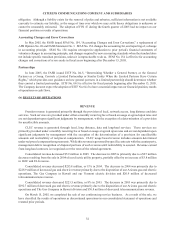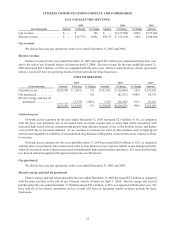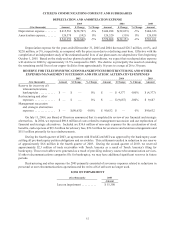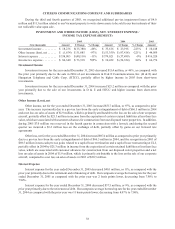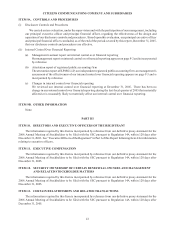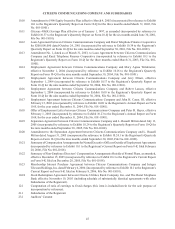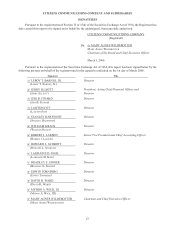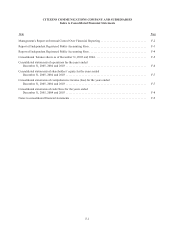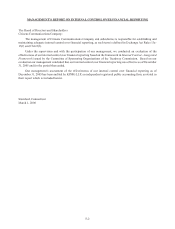Frontier Communications 2005 Annual Report Download - page 41
Download and view the complete annual report
Please find page 41 of the 2005 Frontier Communications annual report below. You can navigate through the pages in the report by either clicking on the pages listed below, or by using the keyword search tool below to find specific information within the annual report.
39
CITIZENS COMMUNICATIONS COMPANY AND SUBSIDIARIES
Income Taxes
Income taxes for the year ended December 31, 2005 increased $73.9 million, as compared with the prior year
primarily due to changes in taxable income and the effective tax rate. The effective tax rate for 2005 was 29.6% as
compared with 13.5% for 2004. Our effective tax rate was below statutory rates in both years as a result of the
completion of audits with federal and state taxing authorities and changes in the structure of certain of our
subsidiaries.
Income taxes for the year ended December 31, 2004 decreased $54.4 million, or 84%, as compared with the
prior year primarily due to changes in taxable income (loss). The effective tax rate for 2004 was 13.5% as compared
with an effective tax rate of 34.3% for 2003.
CUMULATIVE EFFECT OF CHANGE IN ACCOUNTING PRINCIPLE
($ in thousands) 2003
Amount
Cumulative effect of change in accounting principle . . . . . . . . $ 65,769
During the first quarter of 2003, as a result of our adoption of SFAS No. 143, “Accounting for Asset Retirement
Obligations,” we recognized an after tax non-cash gain of approximately $65.8 million.
DISCONTINUED OPERATIONS
($ in thousands) 2005 2004 2003
Amount Amount Amount
Revenue . . . . . . . . . . . . . . . . . . . . . . . . . . . . . . . . . . . . $ 4,607 $ 24,558 $ 20,764
Operating income . . . . . . . . . . . . . . . . . . . . . . . . . . . . $ 1,489 $ 8,188 $ 6,820
Income taxes . . . . . . . . . . . . . . . . . . . . . . . . . . . . . . . . $ 449 $ 2,957 $ 2,440
Net income . . . . . . . . . . . . . . . . . . . . . . . . . . . . . . . . . $ 1,040 $ 5,231 $ 4,380
On March 15, 2005, we completed the sale of CCUSA for $43.6 million in cash. The pre-tax gain on the sale of
CCUSA was $14.1 million. Our after-tax gain was $1.2 million. The book income taxes recorded upon sale are
primarily attributable to a low tax basis in the assets sold.
ITEM 7A. QUANTITATIVE AND QUALITATIVE DISCLOSURES ABOUT MARKET RISK
DISCLOSURE OF PRIMARY MARKET RISKS AND HOW THEY ARE MANAGED
We are exposed to market risk in the normal course of our business operations due to ongoing investing and
funding activities, including those associated with our pension assets. Market risk refers to the potential change in
fair value of a financial instrument as a result of fluctuations in interest rates and equity and commodity prices. We
do not hold or issue derivative instruments, derivative commodity instruments or other financial instruments for
trading purposes. As a result, we do not undertake any specific actions to cover our exposure to market risks and we
are not party to any market risk management agreements other than in the normal course of business or to hedge
long-term interest rate risk.
INTEREST RATE EXPOSURE
Our exposure to market risk for changes in interest rates relates primarily to the interest-bearing portion of our
investment portfolio and interest on our long-term debt and capital lease obligations. The long-term debt and capital
lease obligations include various instruments with various maturities and weighted average interest rates.
Our objectives in managing our interest rate risk are to limit the impact of interest rate changes on earnings and
cash flows and to lower our overall borrowing costs. To achieve these objectives, a majority of our borrowings have
fixed interest rates. Consequently, we have limited material future earnings or cash flow exposures from changes in
interest rates on our long-term debt and capital lease obligations. A hypothetical 10% adverse change in interest rates





